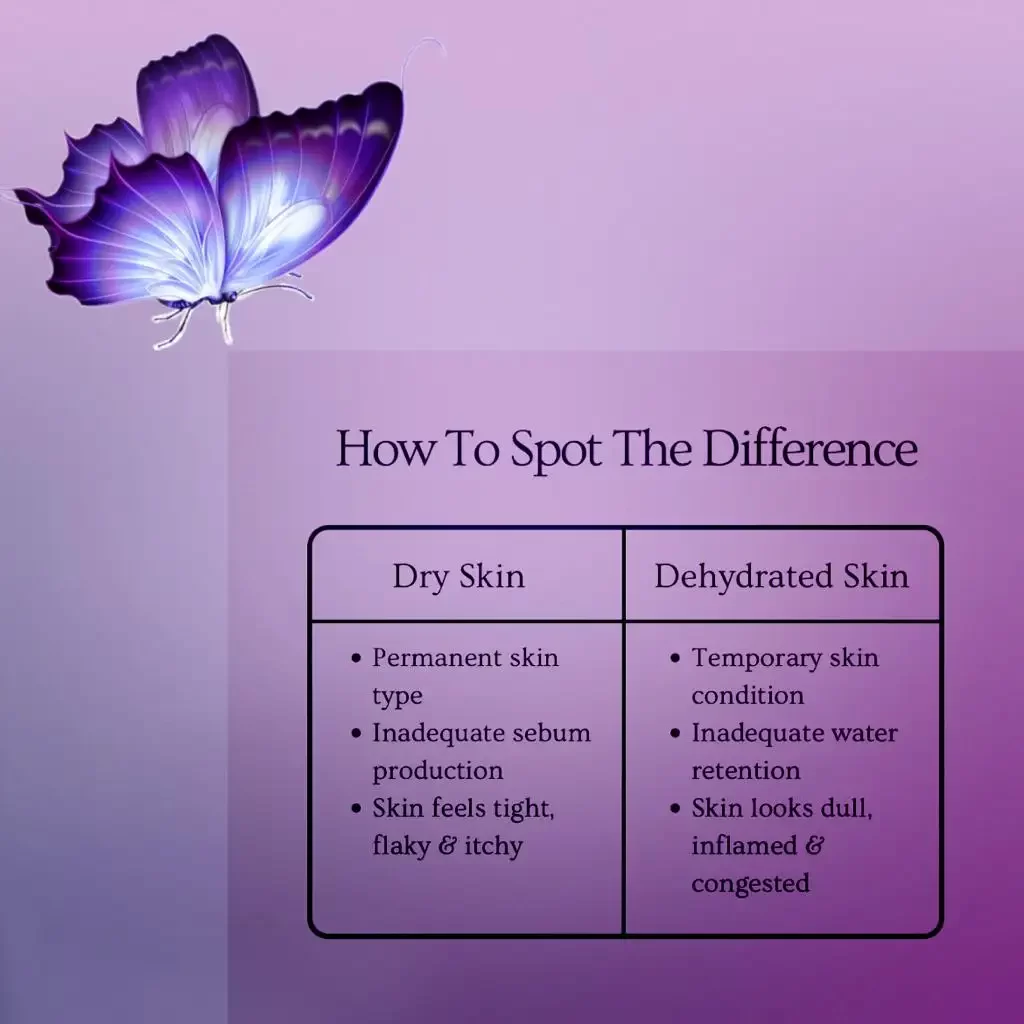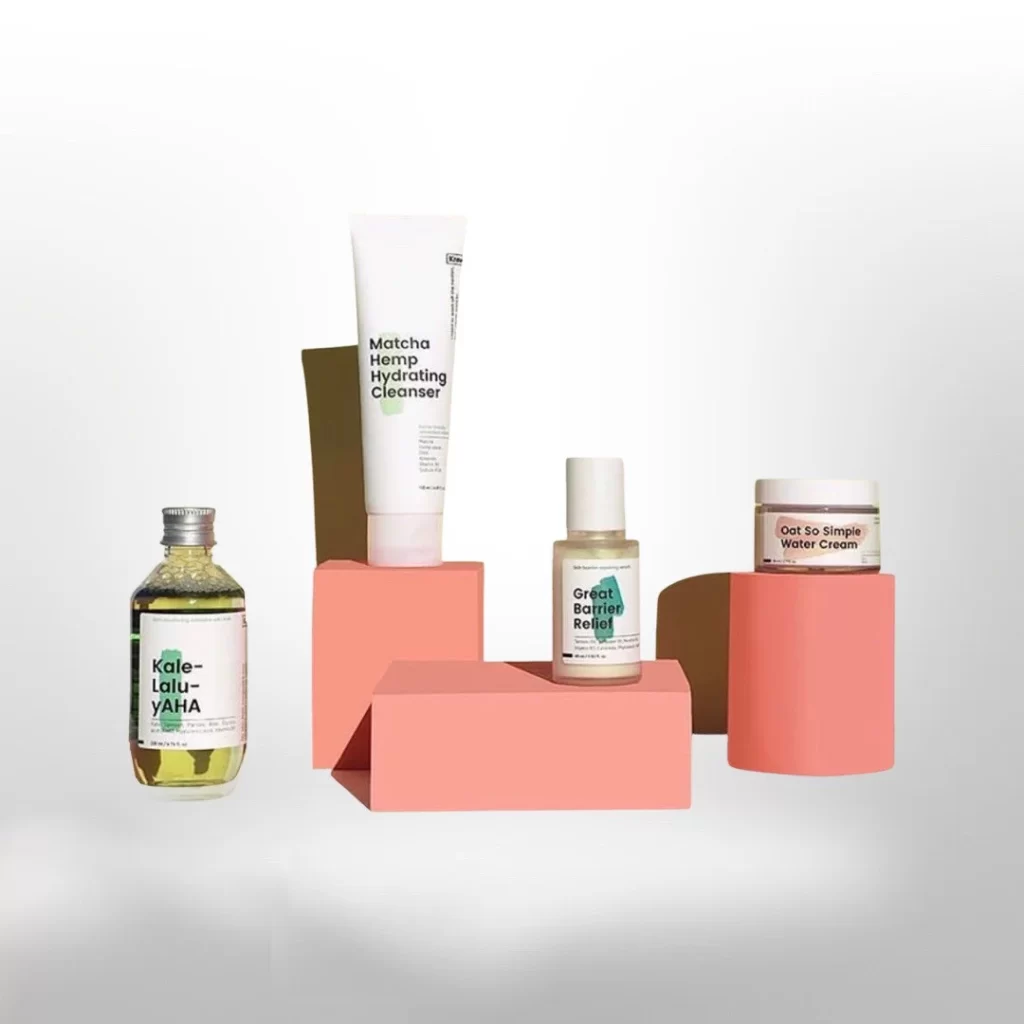Dehydrated skin
It’s a skin condition in which your skin lacks moisture in the surface cells. It can affect any skin type. When the skin is slightly pinched many fine lines and wrinkles are formed, and dehydrated skin can have the appearance of being covered in a thin layer of plastic wrap.
It might also resemble parchment paper in terms of both appearance and feel, and when softly pinched, it shows very fine wrinkles. Dehydration that is more severe will cause the skin to peel, flake, or scale. Frostbite and sunburn are both severe forms of dehydration.
Ageing skin might look much worse when it’s dehydrated. Lack of moisture in surface cells can accentuate the appearance of wrinkles, rough surface texture, and skin sagging.
Dehydration is probably one of the most common conditions. It is caused by the environment, the sun, poor skin care, and the use of skin care products that remove the skin’s natural surface moisture. Dehydration of the skin can also be brought on by a variety of medications and illnesses.
What causes skin dehydration?
Skin becomes dehydrated from too much sun, weather exposure, harsh cleansers, impaired skin barrier function, and ageing.
Skin type and dehydration
Larger pores are a sign of oily skin, medium-sized pores are indicative of normal skin, and tiny, occasionally barely noticeable pores are indicative of dry (alipidic) skin. Dry skin is referred to as alipidic, meaning a lack of lipids is produced by the sebaceous gland present in our skin. People often mistake their dehydrated skin as “dry,” but it is important to distinguish between a lack of sebum flow and a lack of moisture on the skin surface, which is a sign of dehydration. Dehydration can affect any skin type.
How can dehydration be treated?
Using humectants or hydrophilic agents, which draw and bind water to the skin cells and infuse them with moisture, is the most basic method of treating dehydration. The ingredients of moisturisers known as humectants help restore moisture to the skin after cleansing. They are water-binding agents. They have a strong attraction to water and bind water to the skin’s cells, providing the dehydrated skin with moisture.
This smooths the appearance of the skin, helping restore softness and making rough, ageing symptoms look much smoother and younger. By removing dry, dead skin cells from the skin’s surface, exfoliating chemicals like alpha hydroxy acids can help the skin appear and feel smoother.
Toner humectants may include butylene glycol, propylene glycol, and sorbitol. These humectant ingredients are also known for their hydrating and softening effects on the skin.
difference between dry and dehydrated skin
Dry skin
Although it is a skin type dry skin can also be a temporary skin condition.
Dry skin has small pores the skin feels tight, the skin may be flaky, milia, blackheads and spots may be present, and the skin looks dull skin and is not plump. it doesn’t absorb products easily, dry skin is easily irritated, and more likely to suffer reactions to products.
For dry skin look for products using words like nourishing, Bioderma Atoderm Crème is a good moisturizer for dry skin.
Dehydrated skin
It is a skin condition that can affect any skin type which means even oily skin types can have dehydrated skin. It is caused by a lack of water in the skin.
If you have dehydrated skin your skin will feel tight and dry (if you have oily skin your skin can still look shiny and have breakouts). Pores on the skin can be large or small. blackheads and spots are still visible.
The skin has an ashy appearance. Dehydrated skin absorbs moisturizers really quickly in fact if you apply makeup you will notice makeup disappears and goes patchy throughout the day as the skin absorbs any water in your foundation.
For dehydrated skin look for products using words like hydrating like Neutrogena Hydro Boost Hyaluronic Acid Hydrating Water Gel
It is very common for people to have both dry as well as dehydrated skin Cetaphil Moisturizing Cream for Dry & Sensitive Skin is a great moisturizer for dry sensitive and dehydrated skin
Oily dehydrated skin
Many people suffer from dehydrated skin that is also clogged. And people often mistake this skin condition for dry skin. This results in them mistakenly using products made for dry (oil-dry) skin instead of those made for dehydrated (water-dry) skin.
These products designed for dry skin are often full of fatty acids, esters, waxes, oils, and fats. In an attempt to treat their dehydrated skin or wrinkles, they expose oily areas to the excessive fats and oils present in these emollient products, which clog their pores and cause acne and breakouts.
Dryness is not responsible for ageing
Many people have a fear of “dry skin,” because they fear ageing and associate dry skin with ageing. They are unaware that genetics, hormonal factors, and most notably Sun damage are the main causes of ageing rather than dryness.
They attempt to treat Aged skin with oils. This is why it is important to know the difference between dehydration versus oil dryness of the skin. Dehydration makes the skin look dry and flaky, but this does not mean that they need oil; instead, they need water.
How to hydrate the dehydrated skin?
One of two methods can be used to hydrate the skin: Using active ingredients that raise the water content of the skin to reduce dehydration and flaking, improve skin texture and appearance, and help the skin feel better.
Oily dehydrated skin
Adding oily products to this type of skin keeps the skin from further dehydration, but it does not necessarily add significant water to the surface cells. Fatty, oily products often contain comedogenic ingredients. When people with oily skin attempt to “moisturize,” they actually cause clogged pores to form, possibly resulting in acne. Products with these ingredients are not suitable for clog-prone, dehydrated skin.
Almost all hydrating active agents are non-comedogenic. Many emollient active agents for dry (oil-dry) skin are comedogenic. Use non-comedogenic products with non-comedogenic emollient ingredients along with hydrating agents such as sorbitol, sodium PCA, glycerin, or hyaluronic acid. Make sure you check the vehicle’s ingredients for comedogenic ingredients. Most often, the spreading agents are comedogenic.



